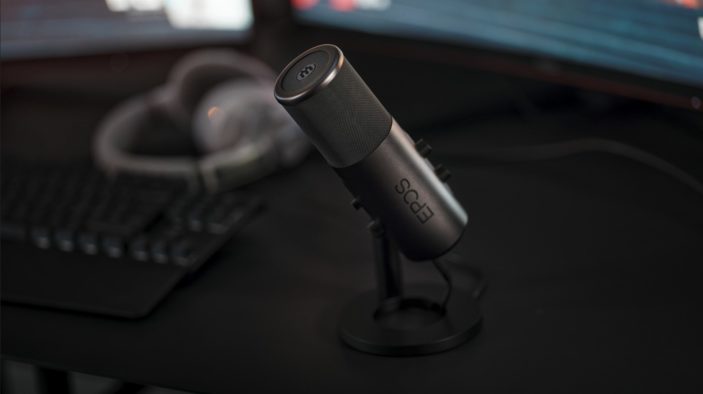
The EPOS B20 microphone is a rock-solid, workhorse microphone for streamers and anyone who needs high-quality vocal audio at home. That’s the elevator pitch. Let’s talk about it.
Design & Features
EPOS is one of the newest kids on the block in terms of PC peripherals. For this newly formalised gaming partner of audio giant Sennheiser, launching a studio-quality streaming mic is a big leap. Senny hasn’t ever produced anything quite like this before. This is a doubly risky move when you consider the EPOS B20 retails for $329 AUD. It is firmly, unquestionably in the premium tier.
If one was to identify the probable ethos of this device, it would likely be “spared no expense.” Every part of the unit, from its design to its packaging, wants you to know you’ve brought something ultra-luxe into your home. The mic is cased in an aluminium chassis with a half-matte finish. External knobs include volume, gain and mute controls and polar pattern selector. If there’s an issue with the design, it’s that it’s trying so hard to be minimalistic that it goes too far. The gain and volume controls are unmarked, and both rotate a full 360 degrees. This makes it hard to manually lock in your settings, or restore them if you accidentally knock the mic with your hand. Instead, you have to feel it out which is a strange approach indeed.
EPOS does have a PC app called the EPOS Gaming Suite that allows for more nuanced tweaking and EQ profiles. This is how EPOS get around not having any markings on the unit. The app is not required to use the mic. It will function just fine out of the box. However, if you’re like me and want to squeeze the best possible sound of EPOS B20, this will be an essential download.
Mounting
The mic itself rests upon a heavy stand that doesn’t consume much desktop real estate. The beauty of the stand is that it can be configured vertically or horizontally depending on what you need it to do. You can mount it on a boom arm if you prefer but you’ll need to make a couple of concessions. The way the controls have been dotted along the fascia means you won’t be able to use a shock cage, and it’ll need to be mounted via the ring base. It’s not a major problem or anything, it just makes fine-tuning your sound and positioning that little bit harder.
Performance
The EPOS B20 has four polar patterns on-board. You can choose from cardioid, omnidirectional, bidirectional, and stereo. For most creators, it’s going to be cardioid and omnidirectional that see the most use. Bi-directional is useful for podcasts or interviews where two people are sitting on opposite sides of a table. Stereo is great if what you’re looking to capture is a broader soundscape, not just the voices in front of the mic, but the sound in the room behind them as well.
I mostly used the cardioid pattern for this review, which captures voice audio perfect for streaming. Because sites like Twitch and YouTube compress the hell out of all video, live or otherwise, that studio-resonance isn’t so important. It keeps you sounding warm and the midrange is very strong. If strong details or clearer sibilants are what you’re chasing, then the Blue Yeti X will likely remain the preferred mic for now. The EPOS B20 certainly doesn’t lack detail, but the Yeti X has a slight edge on it. The Yeti X also seems a bit better at capturing distant voices. At a range of only half a metre, both mics start picking up room noise. Again, the EPOS B20 fell only slightly short of the Yeti X. Its competitor has a more natural sound at range overall.
Where the EPOS B20 leaves Yeti X for dead however is in plosive mitigation and volume levelling. When you holler into a Yeti X so that it peaks, it recoils. The EPOS B20 seems much better prepared for moments like these, handling sudden high-gain inputs in a way that keeps them listenable.
Final thoughts
The EPOS B20 is very much in line with the wider Senny and EPOS range. It marries a presentation inspired by high-end studio setups with rock-solid sound. It gives streamers everything they need out of the box and performs admirably for everyone else. You could plug this into your existing setup, whatever components you may already have, and it will be a neat and complementary fit. You’ll be very happy with it.
The smattering of odd design choices keeps it from being the industry leader it clearly aspires to be. I will be watching future iterations of this hardware very closely. As it stands right now, it can’t quite reach the dizzying highs of Blue’s magisterial Yeti X. However, for EPOS to land so close to the mark on its first attempt is a real feat, one that will have the all-powerful Blue looking over its shoulder.
![]()
![]()
![]()
![]()
![]()
FOUR STARS (OUT OF FIVE)
Highlights: Gorgeous design; Solid sound; EPOS app is strong
Lowlights: No markings make fine-tuning without the app a challenge
Manufacturer: EPOS
Price: $329 AUD RRP
Available: Now
Review conducted with a retail unit provided by the publisher.
